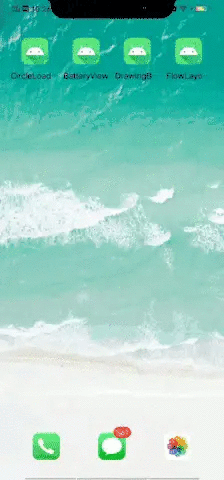Android从0到1实现流布局控件
演示效果:

实现步骤:
2、在onMeasure方法中遍历子view,通过简单计算剩余宽度,用集合存储当前行的几个子view,再根据子view的累加高度设置自己的最终尺寸。
3、在onLayout方法中,遍历每一行,遍历该行的子view,依次调动layout设置子view位置。
核心点:
主要代码:
/*** description 流布局viewGroup*/public class FlowLayoutView extends ViewGroup {private List<Row> rows = new ArrayList<>();private int usedWidth;/*** 当前需要操作的行*/private Row curRow;private int verticalPadding = 30;private int horizontalPadding = 40;public FlowLayoutView(Context context) {super(context);}public FlowLayoutView(Context context, AttributeSet attrs) {super(context, attrs);}@Overrideprotected void onMeasure(int widthMeasureSpec, int heightMeasureSpec) {restoreLine(); //每次重新布局,属性要初始化,避免onMeasure重复调用混乱问题//子view设置宽高为父view大小减去padding值int width = MeasureSpec.getSize(widthMeasureSpec);int height = MeasureSpec.getSize(heightMeasureSpec);int widthMode = MeasureSpec.getMode(widthMeasureSpec);int heightMode = MeasureSpec.getMode(heightMeasureSpec);//设置每个子view宽高,并且将每个子View归到自己的行for (int i = 0; i < getChildCount(); i++) {View childView = getChildAt(i);//设置子view设置AT_MOST模式,即布局属性为wrap_contentint childWidthSpec = MeasureSpec.makeMeasureSpec(width, widthMode == MeasureSpec.EXACTLY ? MeasureSpec.AT_MOST : widthMode);int childHeightSpec = MeasureSpec.makeMeasureSpec(height, heightMode == MeasureSpec.EXACTLY ? MeasureSpec.AT_MOST : heightMode);childView.measure(childWidthSpec, childHeightSpec);if (curRow == null) {curRow = new Row();}//根据当前childview宽度和剩余宽度判断是否能放进当前行,放不了就要换行if (childView.getMeasuredWidth() + horizontalPadding > width - usedWidth) {//先换行,再放入nextLine();}usedWidth += childView.getMeasuredWidth() + horizontalPadding;curRow.addView(childView);}//将最后一个row加入到rows中rows.add(curRow);//根据子view组成的高度重设自己高度int finalHeight = 0;for (Row row : rows) {finalHeight += row.height + verticalPadding;}setMeasuredDimension(width, finalHeight);}@Overrideprotected void onLayout(boolean changed, int l, int t, int r, int b) {int top = 0;//遍历每一行,将每一行子view布局for (Row row : rows) {row.layout(top);top = top + row.height + verticalPadding;}}/*** 换行,需要将当前row存储,并且创建新的row,新的行使用空间置0*/private void nextLine() {rows.add(curRow);curRow = new Row();usedWidth = 0;}/*** 每次onmeasure需要重置信息*/private void restoreLine() {rows.clear();curRow = new Row();usedWidth = 0;}/*** 用于记录每一行放置子View的信息*/class Row {/*** 该行放置的子view*/private List<View> childViews = new ArrayList<>();private int height;public void addView(View view) {childViews.add(view);height = view.getMeasuredHeight() > height ? view.getMeasuredHeight() : height; //高度取最高子view的高度}public int getSize() {return childViews.size();}/*** 将当前childViews进行布局* top 当前hang处于的顶部高度*/public void layout(int top) {int leftMargin = 0;for (int i = 0; i < childViews.size(); i++) {View view = childViews.get(i);view.layout(leftMargin, top, leftMargin + view.getMeasuredWidth(), top + view.getMeasuredHeight());leftMargin = leftMargin + view.getMeasuredWidth() + horizontalPadding;}}}}
MainActivity代码:
public class MainActivity extends AppCompatActivity {private FlowLayoutView flowLayoutView;private String[] tagTextArray = new String[]{"天猫精灵", "充电台灯", "睡衣", "手表", "创意水杯", "夏天T恤男", "灯光机械键盘","计算机原理", "学霸笔记本", "可口可乐", "跑步机", "旅行箱", "竹浆卫生纸", "吹风机", "洗面奶", "窗帘"};protected void onCreate(Bundle savedInstanceState) {super.onCreate(savedInstanceState);setContentView(R.layout.activity_main);init();}private void init() {flowLayoutView = findViewById(R.id.flowlayout);TextView tvAddTag = findViewById(R.id.tv_addtag);tvAddTag.setOnClickListener(new View.OnClickListener() {public void onClick(View v) {View view = LayoutInflater.from(getApplicationContext()).inflate(R.layout.item_tagview, null);TextView tvContent = view.findViewById(R.id.tv_content);tvContent.setText(tagTextArray[(int) (Math.random()*tagTextArray.length)]);flowLayoutView.addView(view);}});}}
评论
